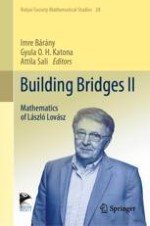2019 | OriginalPaper | Chapter
Embedding Graphs into Larger Graphs: Results, Methods, and Problems
Authors : Miklós Simonovits, Endre Szemerédi
Published in: Building Bridges II
Publisher: Springer Berlin Heidelberg
Activate our intelligent search to find suitable subject content or patents.
Select sections of text to find matching patents with Artificial Intelligence. powered by
Select sections of text to find additional relevant content using AI-assisted search. powered by
